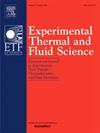微重力条件下非等温晃动的实验表征
IF 3.3
2区 工程技术
Q2 ENGINEERING, MECHANICAL
Experimental Thermal and Fluid Science
Pub Date : 2025-03-22
DOI:10.1016/j.expthermflusci.2025.111473
引用次数: 0
摘要
低温液体推进剂的晃动会不可预测地改变质心,并由于储罐内热量和质量传递的增加而产生巨大的压力波动,从而对航天器的任务安全和性能产生重大影响。这项研究是作为非等温晃动抛物线飞行实验(non-等温晃动抛物线飞行实验)项目的一部分进行的,提供了一个部分填充的直立圆柱形罐在微重力下经历非等温晃动的热力学演变的详细实验研究。在第83次欧洲航天局(ESA)抛物飞行期间,重力的逐步减小引起了晃动,导致在惯性主导条件下自由表面的混乱重新定向。为了研究传热传质对晃动动力学的影响,同时考虑了两个相同的测试单元在单一物种中使用代表流体HFE-7000。一个细胞保持在等温条件下,而另一个细胞开始于最初的热分层条件。对两个细胞进行了流动可视化、压力和温度测量。结果强调了热混合对液体动力学的影响,以及由脱层产生的显著压力和温度波动。所收集的综合实验数据为验证微重力下非等温晃动的数值模拟和简化模型提供了独特的机会,从而有助于改进低温流体管理技术。本文章由计算机程序翻译,如有差异,请以英文原文为准。
Experimental Characterization of non-isothermal sloshing in microgravity
Sloshing of cryogenic liquid propellants can significantly impact a spacecraft’s mission safety and performance by unpredictably altering the center of mass and producing large pressure fluctuations due to the increased heat and mass transfer within the tanks. This study, conducted as part of the NT-SPARGE (Non-isoThermal Sloshing PARabolic FliGht Experiment) project, provides a detailed experimental investigation of the thermodynamic evolution of a partially filled upright cylindrical tank undergoing non-isothermal sloshing in microgravity. Sloshing was induced by a step reduction in gravity during the 83 European Space Agency (ESA) parabolic flight, resulting in a chaotic reorientation of the free surface under inertia-dominated conditions. To investigate the impact of heat and mass transfer on the sloshing dynamics, two identical test cells operating with a representative fluid, HFE-7000, in single-species were considered simultaneously. One cell was maintained in isothermal conditions, while the other started with initially thermally stratified conditions. Flow visualization, pressure, and temperature measurements were acquired for both cells. The results highlight the impact of thermal mixing on liquid dynamics coupled with the significant pressure and temperature fluctuations produced by the destratification. The comprehensive experimental data gathered provide a unique opportunity to validate numerical simulations and simplified models for non-isothermal sloshing in microgravity, thus contributing to improved cryogenic fluid management technologies.
求助全文
通过发布文献求助,成功后即可免费获取论文全文。
去求助
来源期刊

Experimental Thermal and Fluid Science
工程技术-工程:机械
CiteScore
6.70
自引率
3.10%
发文量
159
审稿时长
34 days
期刊介绍:
Experimental Thermal and Fluid Science provides a forum for research emphasizing experimental work that enhances fundamental understanding of heat transfer, thermodynamics, and fluid mechanics. In addition to the principal areas of research, the journal covers research results in related fields, including combined heat and mass transfer, flows with phase transition, micro- and nano-scale systems, multiphase flow, combustion, radiative transfer, porous media, cryogenics, turbulence, and novel experimental techniques.
 求助内容:
求助内容: 应助结果提醒方式:
应助结果提醒方式:


